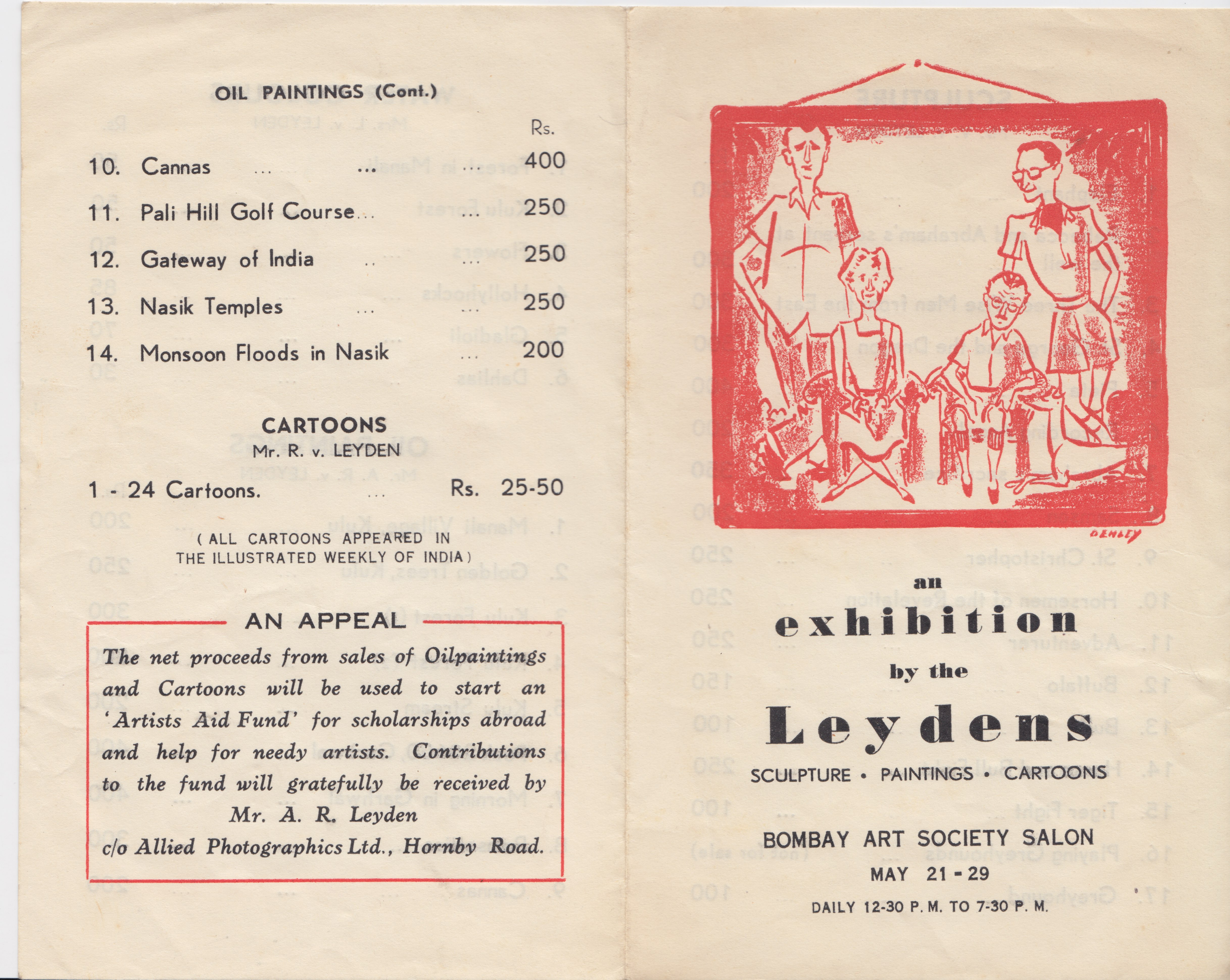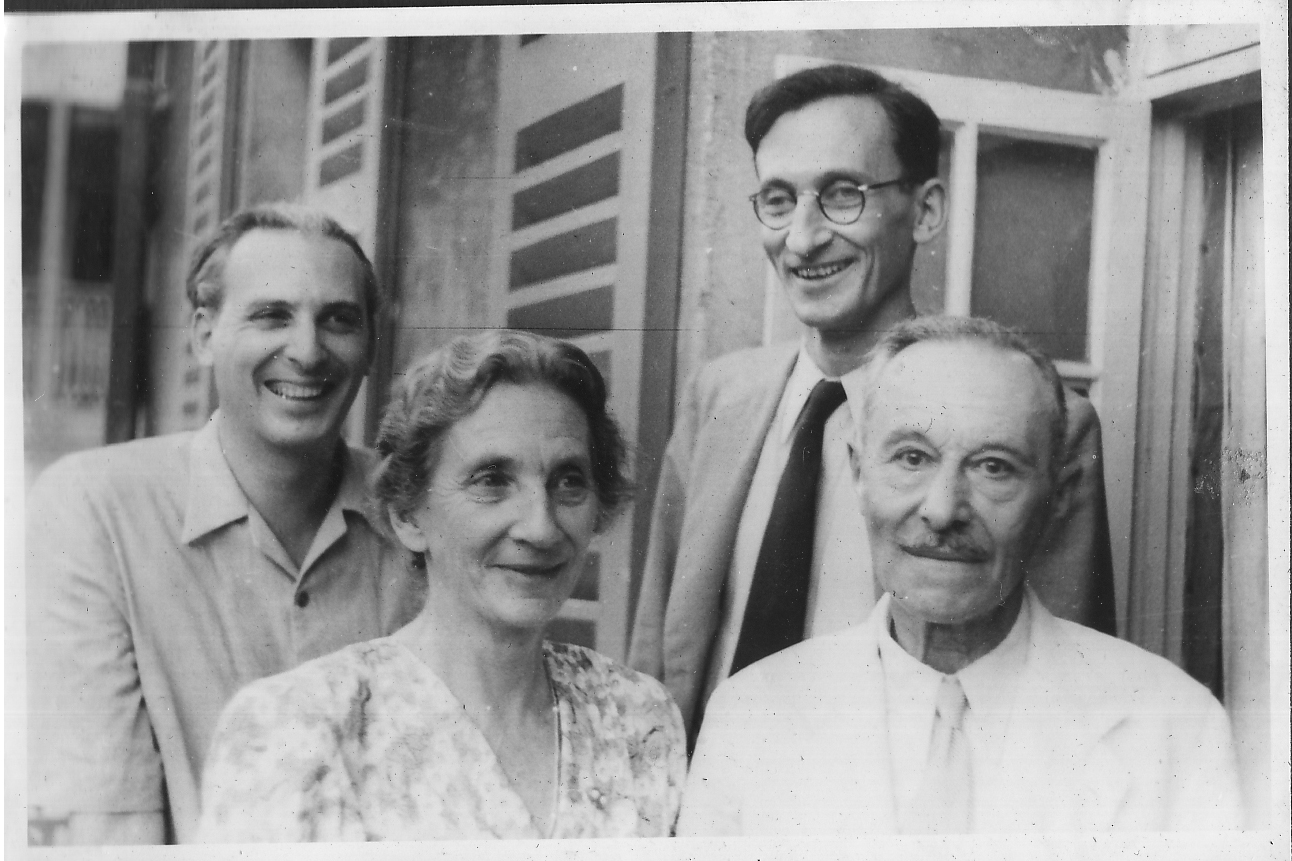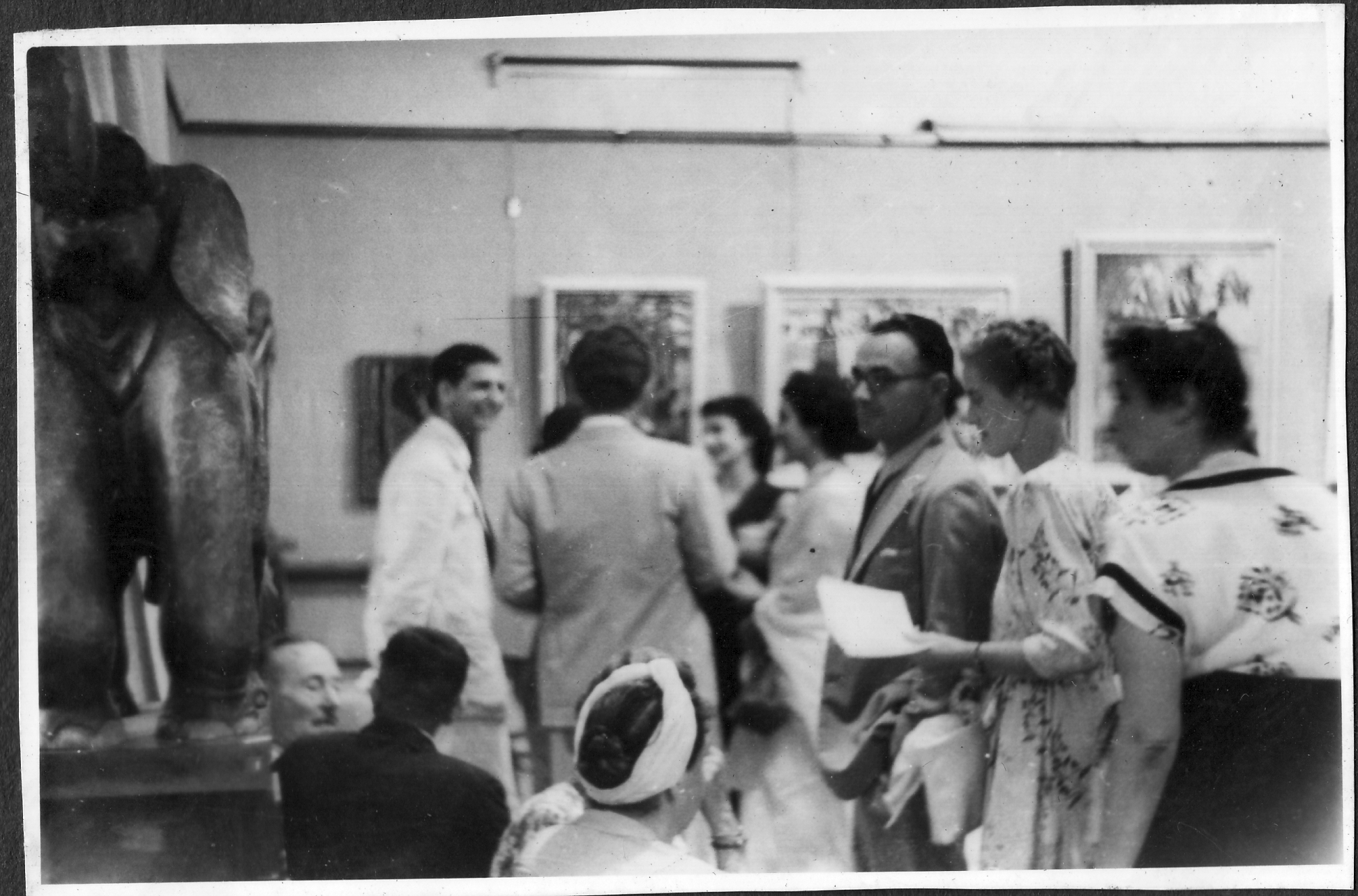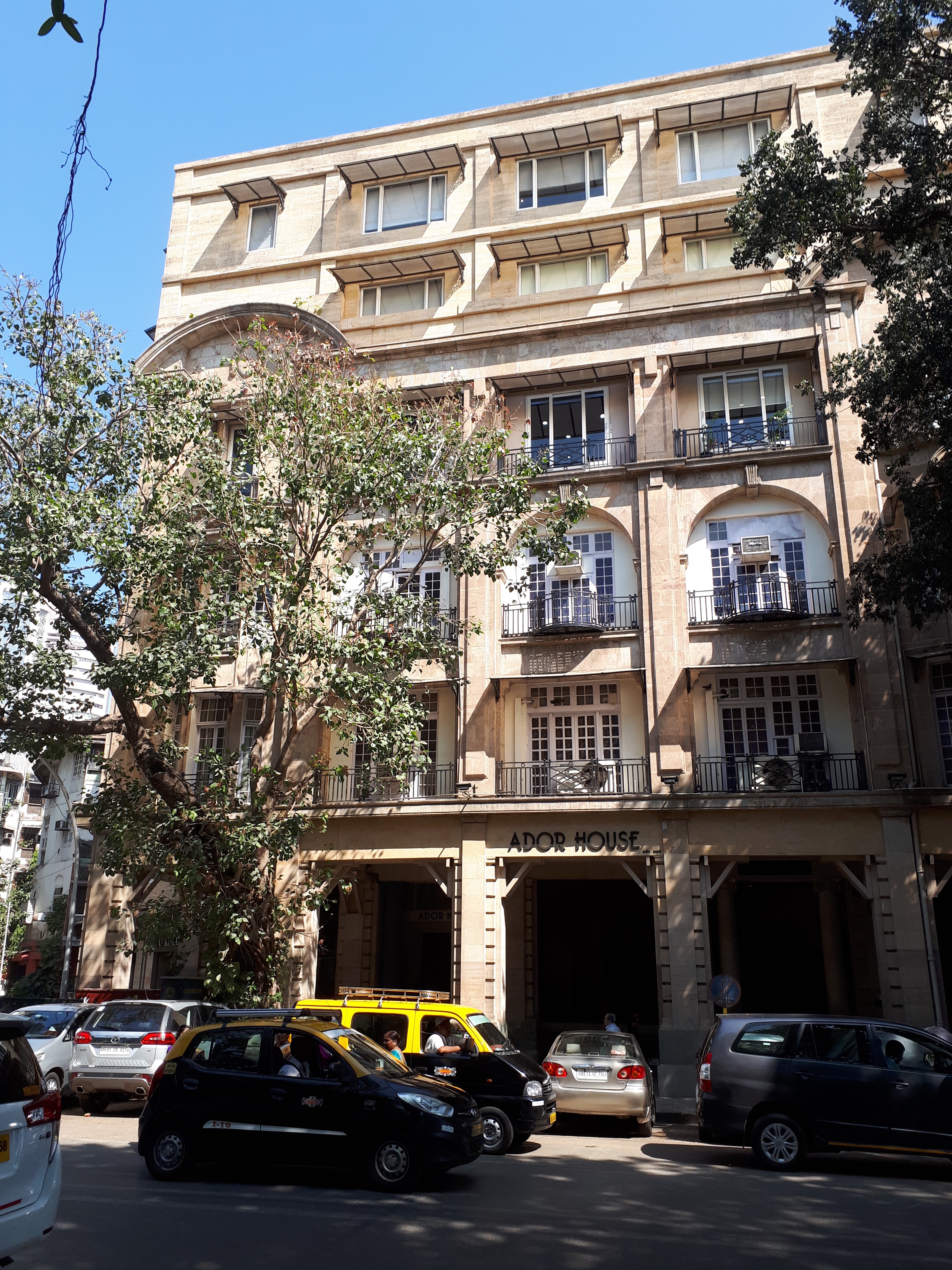Archive
The Leydens: Sculpture, Paintings, Cartoons
The Leydens: Sculpture, Paintings, Cartoons
Word Count: 5
- The Leydens: Sculpture, Paintings, Cartoons
- Exhibition
- 21-05-1948
- 29-05-1948
In 1948 Albrecht and Rudi von Leyden sold their personal works of art in order to set up an “Artists' Aid Fund”, which became an institution in the following years.
Word Count: 29

Folder for the Leyden exhibition in May 1948, front and back (© Private Archive Flora Veit-Wild, Berlin; All Rights Reserved). 
Folder (inside) for the Leyden exhibition in May 1948 with the titles of the exhibits (© Private Archive Flora Veit-Wild, Berlin; All Rights Reserved). 
The four exhibiting artists: Luise and Victor Ernst von Leyden (front), Rudolf and Albrecht von Leyden (with glasses) (back) (© Private Archive James von Leyden, Lewes; All Rights Reserved). 
The opening was well attended: in front the Elephant, woodcarving by Victor Ernst von Leyden (far left), who is sitting under his sculpture in conversation with a gentleman, his wife Luise (with a headscarf, from behind) sitting in the same row. Käthe Langhammer moves to the far right in the photo; the group at the back in front of the oil paintings by Albrecht von Leyden (from left): Kekoo Gandhy, Walter Langhammer (from behind), Khorshed Gandhy in conversation with two unknown women (© Private Archive James von Leyden, Lewes; All Rights Reserved). 
Rudolf von Leyden´s Denley caricatures on display and for sale (© Private Archive James von Leyden, Lewes; All Rights Reserved). 
The financial person behind the project: Albrecht “Lolly” von Leyden, an enthusiastic amateur painter, self-portrait from later years, n.d. (painting currently lost; Photo: Margit Franz, 2004; All Rights Reserved). 
Main entrance to Ador House, the exhibition venue in the salon of the Bombay Art Society, 2018 (Photo: Margit Franz; All Rights Reserved). 
Ador House, exhibition venue in the Bombay Art Society Salon, 2018 (Photo: Margit Franz; All Rights Reserved). Anonymous. “Leydenʼs Family Art Works: Bombay Exhibition.” The Times of India, 22 May 1948, p. 9.
Arbuthnot, Mollie. “Bombay Satire: Rudolf von Leydenʼs Political Cartoons in India in the 1930s and 40s.” 12 December 2018, British Library, Asian and African studies blog, blogs.bl.uk/asian-and-african/2018/12/bombay-satire-rudolf-von-leydens-political-cartoons-in-india-in-the-1930s-and-40s-.html. Accessed 10 April 2021.
Dalmia, Yashodhara. The Making of Modern Indian Art: The Progressives. Oxford University Press, 2001.
Franz, Margit. Gateway India: Deutschsprachiges Exil in Indien zwischen britischer Kolonialherrschaft, Maharadschas und Gandhi. CLIO, 2015.
Franz, Margit. “From Dinner Parties to Galleries: The Langhammer-Leyden-Schlesinger Circle in Bombay – 1940s through the 1950s.” Arrival Cities. Migrating Artists and New Metropolitan Topographies in the 20th Century, edited by Burcu Dogramaci et al., Leuven University Press, 2020, pp. 73–90. Project Muse, doi: 10.1353/book.77990. Accessed 30 March 2021.
Gopalakrishnan, V.S. “‘Art is Man’s Nature; Nature is God’s Art’. Philips James Bailey (1816–1912).” Jubilant Gold: 50 Years of Artistsʼ Centre, A Celebratory Exhibition of Works of K.H. Ara, S. Bakre, H.A. Gade, M.F. Husain, S.H. Raza, F.N. Souza, exh. cat. Artistsʼ Centre, Mumbai, 2001, n.p.
Leyden, Wolfgang von. Growing up under the Weimar Republic, 1918–1933. Vantage Press, 1984.
Veit-Wild, Flora, “‘Es ist kein Traum, Dir auf Deinen ersten richtigen Brief zu antworten...’. Luise von Leyden als Chronistin jüdischen Exils in Indien.” Das Ende des Exils? Briefe von Frauen nach 1945 (Frauen und Exil, 7), edited by Irene Below et al., edition text + kritik, 2014, pp. 88–104.
Wikipedia, the free encyclopedia. “Ernst Viktor von Leyden.” 8 September, Wikipedia, en.wikipedia.org/wiki/Ernst_Viktor_von_Leyden. Accessed 10 April 2021.
Word Count: 249
Private Private Archive Flora Veit-Wild Archive, Berlin.
Private Archive James von Leyden, Lewes.
Private Archive Margit Franz, Sinabelkirchen.Word Count: 18
6 Rampart Row, Kala Ghoda, Bombay (now 6, K Dubash Marg, Kala Ghoda, Fort, Mumbai).
- Bombay
- Margit Franz. "The Leydens: Sculpture, Paintings, Cartoons." METROMOD Archive, 2021, https://archive.metromod.net/viewer.p/69/2951/object/5141-11941872, last modified: 14-09-2021.
-
Rudolf von LeydenGeologistAdvertisement SpecialistJournalistArt CriticArt CollectorCartoonistBombay
The advertisement expert, Rudolf von Leyden, became a major art critic and art historian in Bombay in the 1940s, advocating an urgent need for modernism in art in post-colonial India.
Word Count: 30
Emanuel SchlesingerFactory OwnerTechnical DirectorArt CollectorArt CriticBombayThe art collector Schlesinger provided primarily financial aid by creating working opportunities for young artists in post-independence Bombay, and initiated the corporate culture of buying art.
Word Count: 26
Ernst N. SchaefferJournalistPhotojournalistTour GuideEditorRadio ModeratorNewspaper CorrespondentBombayIn exile Ernst Schaeffer diversified his journalistic practice and developed an understanding of Bombay through walking the city streets, taking on street-level-photography and photojournalism.
Word Count: 24
Schimmel’s Wedding Film 1948FilmBombayThe film shows Schimmel’s Jewish wedding ceremony at the prestigious Glamis Villa, followed by lunch at the Taj Mahal Hotel. Among the guests were Käthe and Walter Langhammer.
Word Count: 30
Open Studio Evenings by Käthe and Walter LanghammerSalonBombayThe painter Walter Langhammer and his wife Käthe built an informal infrastructure to promote local avant-garde artists and regularly invited them to Open Studio Evenings at their studio.
Word Count: 29
Jehangir Art GalleryArt GalleryAuditorium HallLibraryBombayEfforts to create spaces for the democratic presentation, discussion and reflection of art in Bombay after independence led to the establishment of the Jehangir Art Gallery in 1952.
Word Count: 27
Bombay Art SocietyAssociationBombayOne of the oldest art societies in India founded by colonial rulers, Bombay Art Society showcased art students and professional artists from all over India, including the Progressive Artists of Bombay.
Word Count: 31